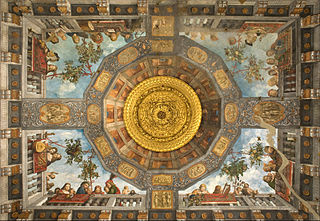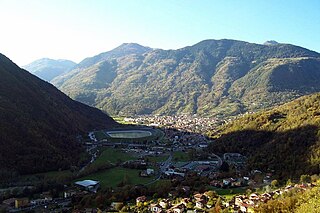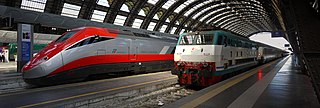
The Rhaetian Railway, abbreviated RhB, is a Swiss transport company that owns the largest network of all private railway operators in Switzerland. Headquartered in Chur, the RhB operates all the railway lines of the Swiss canton of Grisons, except for the line from Sargans to the cantonal capital, Chur, which are operated by Swiss Federal Railways (SBB CFF FFS), as well as the line from Disentis/Mustér to the Oberalp Pass and further on to Andermatt, Uri, which is operated by Matterhorn Gotthard Bahn (MGB). Inaugurated in 1888 and expanded from 1896 onwards in various sections, the RhB network is located almost entirely within Grisons, with one station across the Italian border at Tirano.

Trompe-l'œil is an artistic term for the highly realistic optical illusion of three-dimensional space and objects on a two-dimensional surface. Trompe l'œil, which is most often associated with painting, tricks the viewer into perceiving painted objects or spaces as real. Forced perspective is a related illusion in architecture.

Edolo is a town and comune in the province of Brescia, Lombardy, northern Italy, located in the upper Camonica valley. Edolo is neighbour to the comuni of Corteno Golgi, Incudine, Lovero, Malonno, Monno, Ponte di Legno, Saviore dell'Adamello, Sernio, Sonico, Temù, Tovo di Sant'Agata, Vezza d'Oglio and Vione.

Valtellina or the Valtelline ; Lombard: Valtelina or Valtulina; German: Veltlin; Italian: Valtellina) is a valley in the Lombardy region of northern Italy, bordering Switzerland. Today it is known for its ski centre, hot spring spas, bresaola, cheeses and wines. In past centuries it was a key Alpine pass between northern Italy and Germany. The control of the Valtellina was much sought after, particularly during the Thirty Years' War as it was an important part of the Spanish Road.

The Italian railway system is one of the most important parts of the infrastructure of Italy, with a total length of 24,227 km (15,054 mi) of which active lines are 16,723 km (10,391 mi). The network has recently grown with the construction of the new high-speed rail network. Italy is a member of the International Union of Railways (UIC). The UIC Country Code for Italy is 83.

Campagna is a small town and comune of the province of Salerno, in the Campania region of Southern Italy. Its population is 17,148. Its old Latin name was Civitas Campaniae. Campagna is located in one of the valleys of the Picentini Mountains, at an altitude of 270 meters above sea level.

Poschiavo is a municipality in the Bernina Region in the canton of Grisons in Switzerland.

Poppi is a comune (municipality) in the Province of Arezzo in the Italian region Tuscany, located about 40 km east of Florence and about 30 km northwest of Arezzo.

Val Poschiavo is a valley in the southern, Italian-speaking part of the Swiss canton of Graubünden (Grisons). The main town is Poschiavo.

The Albula railway line is a single track metre gauge railway line forming part of the core network of the Rhaetian Railway (RhB), in the canton of Graubünden, Switzerland. It links Thusis on the Hinterrhein at 697 m (2,287 ft) and Filisur at 1,080 m (3,540 ft) with the spa resort of St. Moritz in Engadine at 1,774 m (5,820 ft).

The Bernina railway line is a single-track 1,000 mmmetre gauge railway line forming part of the Rhaetian Railway (RhB). It links the spa resort of St. Moritz, in the canton of Graubünden, Switzerland, with the town of Tirano, in the Province of Sondrio, Italy, via the Bernina Pass. Reaching a height of 2,253 metres (7,392 ft) above sea level, it is the third highest railway crossing in Europe and the third-highest railway in Switzerland. It also ranks as the highest adhesion railway of the continent, and – with inclines of up to 7% – as one of the steepest adhesion railways in the world. The elevation difference on the section between the Bernina Pass and Tirano is 1,824 m (5,984 ft), allowing passengers to view glaciers along the line.

The Palazzo Comunale, also known as the Palazzo del Popolo of San Gimignano has been the seat of the civic authority in the comune since the 13th century. It is located on the Piazza del Duomo close to the Collegiate Church of the Assumption of the Blessed Virgin Mary. The building and Collegiate Church are at the heart of the medieval town, and are part of the UNESCO World Heritage Site of the "Historic Centre of San Gimignano".

Le Prese railway station is a railway station in the village of Le Prese, within the municipality of Poschiavo and canton of Graubünden in Switzerland. It is located on the Bernina line of the Rhaetian Railway.

Miralago railway station, previously known as Meschino railway station, is a station in the village of Miralago, within the municipality of Poschiavo and in the Swiss canton of Graubünden. It is located on the Bernina line of the Rhaetian Railway.

Campocologno railway station is a railway station in the municipality of Brusio, in the Swiss canton of Graubünden. It is located at the border between Italy and Switzerland and is an intermediate stop on the 1,000 mmmetre gauge Bernina line of the Rhaetian Railway. Hourly services operate on this line.

Tirano railway station is one of two stations in Tirano, Italy. It is the southern terminus of the metre gauge Bernina line of the Rhaetian Railway from St. Moritz. Hourly services operate on this line. It is adjacent to the main-line Rete Ferroviaria Italiana Tirano railway station.

Tirano railway station (RFI) is one of two railway stations within the town and comune of Tirano, in the region of Lombardy, northern Italy. Opened in 1902, it is the terminus of the Tirano–Lecco railway.

The Brusio spiral viaduct is a single-track nine-arched stone spiral railway viaduct on the Bernina Railway. It was opened on 1 July 1908.

The Palazzo Salis is situated in the heart of the historic centre of Tirano, a small town in the valley Valtellina in the north of Italy. The building got constructed during the second half of the 17th century by the noble family von Salis-Zizers, a branch of the important and well known grison family von Salis.

























